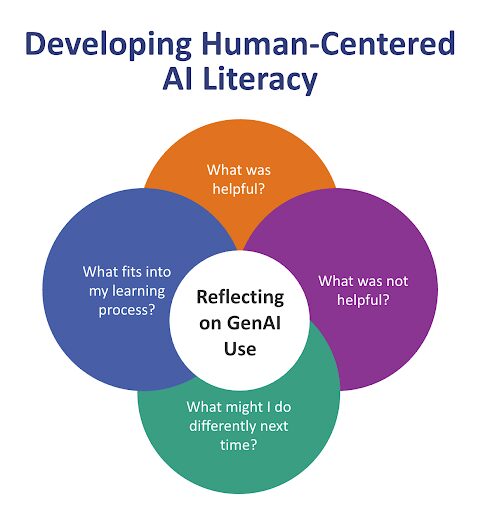
The National Leadership Cohort, in collaboration with Digital Promise’s League of Innovative Schools, has helped address critical questions about the future of AI-enhanced literacy instruction. A key effort includes developing a better understanding of when to use AI, when to skip it, and how to decide.
In the last several years, educators have been asking themselves: how does GenAI impact my class?
Teachers can address the tension created by this new digital technology, provide students with essential AI literacy, and determine when it supports learning authentically versus when it undermines necessary skill-building for students. Understanding the fundamentals of AI in education can help educators to support access for all learners, and seeking opportunities to collaborate with colleagues can help educators to develop practical applications for their classrooms and schools.
First, teachers (and students) need to understand the basics of large language models (LLMs) and AI writing tools’ functions, strengths, weaknesses, and biases. Teachers can then consider the learning objectives in their course to see if there is a good fit for generative AI.
For example, are students having difficulty understanding “voice” or audience in their writing? GenAI can assist students as they explore and critically analyze AI outputs—determining whether they think it is appropriate or not—and discuss ways they might change the voice of their writing to adapt it to a relevant audience. This can help students learn what type of information leads to the most successful AI outputs when considering their AI prompts. Students also gain AI literacy skills working under the supervision of a teacher who is scaffolding their learning.
In order to navigate the rapidly evolving AI tools and uses, teachers should identify their own beliefs about effective and responsible use of AI for educational purposes. We suggest looking to prior digital technology integration for insights on how to productively integrate this new technology, as well as evolving research on scaffolding versus off-loading. Find colleagues interested in advancing AI in the classroom, join a network or learning community (like the Playful Learning Community), and follow key thought leaders. You don’t need to navigate this alone!
View the English and Spanish glossary written for educators to reference when learning about and using AI. It starts with a definition of artificial intelligence and then provides definitions of AI-related terms.
Teachers can construct student learning with AI in productive and human-centered ways. Research at both Digital Promise and the University of California, Irvine, has found it is important to help students create a habit of thinking first before turning to AI. There are many psychological reasons for this, but basically, we want to communicate to students two things—that they know much more than they realize about what they want out of the AI (e.g., what is interesting to them) and that once they start with the AI, they are unlikely to veer from its path. This is just human nature (aka psychological science).
We want to communicate to students two things—that they know much more than they realize about what they want out of the AI (e.g., what is interesting to them) and that once they start with the AI, they are unlikely to veer from its path
 If students think first, they are also better prepared to craft a good AI prompt with a clear goal and details based on their thinking. A key finding from our work is that students need to be taught iterative prompting; we even suggest giving them phrases to help them direct the AI to clarify, expand, shorten, or otherwise adapt the initial AI output to better meet the student’s needs. We often refer to this process as “being the boss” of the AI. Teachers should reinforce skills like checking sources, corroborating information, and ensuring that AI-generated text is accurate when that is an appropriate concern. This is a critical skill in the age of ubiquitous AI, and instructors can look to resources from librarians and historians to teach and practice verifying facts.
If students think first, they are also better prepared to craft a good AI prompt with a clear goal and details based on their thinking. A key finding from our work is that students need to be taught iterative prompting; we even suggest giving them phrases to help them direct the AI to clarify, expand, shorten, or otherwise adapt the initial AI output to better meet the student’s needs. We often refer to this process as “being the boss” of the AI. Teachers should reinforce skills like checking sources, corroborating information, and ensuring that AI-generated text is accurate when that is an appropriate concern. This is a critical skill in the age of ubiquitous AI, and instructors can look to resources from librarians and historians to teach and practice verifying facts.
Finally, reflect on the experience of using GenAI. Students should consider what was helpful, what was not, what they might do differently, and what fits into their own learning process the best. Some students will decide that AI is more troublesome than worthwhile, while others will learn how to ask better questions of the AI and how to use it productively without undermining students’ agency. By reflecting, students are more likely to assimilate the lessons learned in the process and be in a position to make even better decisions in the future.
Find more resources here:
Sign up for the Digital Learning Lab’s blog and the U-GAIN Reading newsletter to stay updated on generative AI and education.